Effect of Annealing Process on Microstructure and Magnetic Properties of FeSiBPCNbCu Nanocrystalline Soft Magnetic Powder Cores
Abstract
:1. Introduction
2. Materials and Methods
3. Results and Discussion
3.1. Characterization of Fe74.75Si8B10P3C2Nb1.5Cu0.75 Powder and NPCs Coating Behavior
3.2. Magnetic Properties and Microstructures of Fe74.75Si8B10P3C2Nb1.5Cu0.75 NPCs Annealed at Different HR
3.3. Magnetic Properties and Microstructures of Fe74.75Si8B10P3C2Nb1.5Cu0.75 NPCs Annealed for Different HT
3.4. Magnetic Domain Motion Behavior of Fe74.75Si8B10P3C2Nb1.5Cu0.75 NPCs
3.5. Nanocrystallization Processes of Fe74.75Si8B10P3C2Nb1.5Cu0.75 NPCs
4. Conclusions
- (1)
- The moderate HR and HT of 100 K/min and 30 min lead to a finely uniform nanocrystalline structure, which shows a concentrated grain size distribution and a fine grain size of 18.71 nm.
- (2)
- The NPCs annealed under the HR and HT of 100 K/min and 30 min show a modified magnetic domain structure, where no obvious pinning points can be observed, and the domain wall moves easier than that of the NPCs annealed under other annealing conditions, which indicates the reduction of Hc.
- (3)
- The NPCs annealed under the HR and HT of 100 K/min and 30 min show excellent comprehensive soft magnetic properties, including a low Hc of 10.5 A/m 7.0 (50 mT, 500 kHz), high μe of 64.7 (100 kHz), and low Pcv of 751 mW/cm3 (50 mT, 500 kHz).
Author Contributions
Funding
Institutional Review Board Statement
Informed Consent Statement
Data Availability Statement
Conflicts of Interest
References
- Yoshizawa, Y.; Oguma, S.; Yamauchi, K. New Fe-based soft magnetic alloys composed of ultrafine grain structure. J. Appl. Phys. 1988, 64, 6044–6046. [Google Scholar] [CrossRef]
- Zhang, Y.; Sharma, P.; Makino, A. Fe-Rich Fe-Si-B-P-Cu Powder Cores for High-Frequency Power Electronic Applications. IEEE Trans. Magn. 2014, 50, 1–4. [Google Scholar] [CrossRef]
- McHenry, M.E.; Willard, M.A.; Laughlin, D.E. Amorphous and nanocrystalline materials for applications as soft magnets. Prog. Mater. Sci. 1999, 44, 291–433. [Google Scholar] [CrossRef]
- Herzer, G. Modern soft magnets: Amorphous and nanocrystalline materials. Acta Mater. 2013, 61, 718–734. [Google Scholar] [CrossRef]
- Kim, Y.B.; Jee, K.K.; Choi, G.B. Fe-based nanocrystalline alloy powder cores with excellent high frequency magnetic properties. J. Appl. Phys. 2008, 103, 07E704. [Google Scholar] [CrossRef]
- Cho, E.K.; Kwon, H.T.; Cho, E.M.; Song, Y.S.; Sohn, K.Y.; Park, W.W. The control of nano-grain size and magnetic properties of Fe73Si16B7Nb3Cu1 soft magnetic powder cores. Mater. Sci. Eng. A 2007, 449–451, 368–370. [Google Scholar] [CrossRef]
- Kim, T.H.; Jee, K.K.; Kim, Y.B.; Byun, D.J.; Han, J.H. High-frequency magnetic properties of soft magnetic cores based on nanocrystalline alloy powder prepared by thermal oxidation. J. Magn. Magn. Mater. 2010, 322, 2423–2427. [Google Scholar] [CrossRef]
- Alvarez, K.L.; Baghbaderani, H.A.; Martín, J.M.; Burgos, N.; Ipatov, M.; Pavlovic, Z.; McCloskey, P.; Masood, A.; Gonzalez, J. Novel Fe-based amorphous and nanocrystalline powder cores for high-frequency power conversion. J. Magn. Magn. Mater. 2020, 501, 166457. [Google Scholar] [CrossRef]
- Wang, Y.; Lucia, O.; Zhang, Z.; Gao, S.; Guan, Y.; Xu, D. A Review of High Frequency Power Converters and Related Technologies. IEEE Ind. Electron. Soc. 2020, 1, 247–260. [Google Scholar] [CrossRef]
- de Groot, H.; Janssen, E.; Pagano, R.; Schetters, K. Design of a 1-MHz LLC Resonant Converter Based on a DSP-Driven SOI Half-Bridge Power MOS Module. IEEE Trans. Power Electron. 2007, 22, 2307–2320. [Google Scholar] [CrossRef]
- Pang, L.L.; Inoue, A.; Zanaeva, E.N.; Wang, F.; Bazlov, A.I.; Han, Y.; Kong, F.L.; Zhu, S.L.; Shull, R.B. Nanocrystallization, good soft magnetic properties and ultrahigh mechanical strength for Fe82-85B13-16Si1Cu1 amorphous alloys. J. Alloys Compd. 2019, 785, 25–37. [Google Scholar] [CrossRef]
- Herzer, G. Grain size dependence of coercivity and permeability in nanocrystalline ferromagnets. IEEE Trans. Magn. 1990, 26, 1397–1402. [Google Scholar] [CrossRef]
- Li, Z.; Parsons, R.; Kishimoto, H.; Shoji, T.; Kato, A.; Karel, J.; Suzuki, K. Nanocrystalline (Fe, Co, Ni)86B14 soft magnetic alloys prepared by ultra-rapid annealing. J. Alloys Compd. 2022, 902, 162544. [Google Scholar] [CrossRef]
- Jiang, L.; Zhang, Y.; Tong, X.; Suzuki, T.; Makino, A. Unique influence of heating rate on the magnetic softness of Fe81.5Si0.5B4.5P11Cu0.5C2 nanocrystalline alloy. J. Magn. Magn. Mater. 2019, 471, 148–152. [Google Scholar] [CrossRef]
- Meng, Y.; Pang, S.J.; Chang, C.T.; Bai, X.Y.; Zhang, T. Nanocrystalline Fe83Si4B10P2Cu1 ribbons with improved soft magnetic properties and bendability prepared via rapid annealing of the amorphous precursor. J. Magn. Magn. Mater. 2021, 523, 167583. [Google Scholar] [CrossRef]
- Yoshida, K.; Bito, M.; Kageyama, J.; Shimizu, Y.; Abe, M.; Makino, A. Unusual high Bs for Fe-based amorphous powders produced by a gas-atomization technique. AIP Adv. 2016, 6, 055933. [Google Scholar] [CrossRef] [Green Version]
- Yoshida, S.; Mizushima, T.; Hatanai, T.; Inoue, A. Preparation of new amorphous powder cores using Fe-based glassy alloy. IEEE Trans. Magn. 2000, 36, 3424–3429. [Google Scholar] [CrossRef]
- Chang, C.; Dong, Y.; Liu, M.; Guo, H.; Xiao, Q.; Zhang, Y. Low core loss combined with high permeability for Fe-based amorphous powder cores produced by gas atomization powders. J. Alloys Compd. 2018, 766, 959–963. [Google Scholar] [CrossRef]
- Duhaj, P.; Maťko, I.; Švec, P.; Janičkovič, D. Structural characterization of the finemet type alloys. J. Non-Cryst. Solids 1995, 193, 561–564. [Google Scholar] [CrossRef]
- Parsons, R.; Zang, B.; Onodera, K.; Kishimoto, H.; Kato, A.; Suzuki, K. Soft magnetic properties of rapidly-annealed nanocrystalline Fe-Nb-B-(Cu) alloys. J. Alloys Compd. 2017, 723, 408–417. [Google Scholar] [CrossRef]
- Ohta, M.; Yoshizawa, Y. Effect of Heating Rate on Soft Magnetic Properties in Nanocrystalline Fe80.5Cu1.5Si4B14 and Fe82Cu1Nb1Si4B12 Alloys. Appl. Phys. Express 2009, 2, 2. [Google Scholar] [CrossRef]
- Suzuki, K.; Herzer, G. Magnetic-field-induced anisotropies and exchange softening in Fe-rich nanocrystalline soft magnetic alloys. Scr. Mater. 2012, 67, 548–553. [Google Scholar] [CrossRef]
- Florio, G. Structural Features of Magnetic Materials. In Encyclopedia of Smart Materials; Olabi, A.-G., Ed.; Elsevier: Amsterdam, The Netherlands, 2022; Volume 5, pp. 1–9. [Google Scholar]
- Long, J.; Qin, Y.; Nuhfer, T.; De Graef, M.; Laughlin, D.E.; McHenry, M.E. Magnetic domain observations in a FeCo-based nanocrystalline alloy by Lorentz microscopy. J. Appl. Phys. 2007, 101, 09N115. [Google Scholar] [CrossRef] [Green Version]
- Saito, K.; Park, H.S.; Shindo, D.; Yoshizawa, Y. Magnetic domain structure in Fe78.8-xCoxCu0.6Nb2.6Si9B9 nanocrystalline alloys studied by Lorentz microscopy. J. Magn. Magn. Mater. 2006, 305, 304–309. [Google Scholar] [CrossRef]
- Avramovic-Cingara, G.; Zweck, J.; Giallonardo, J.D.; Palumbo, G.; Erb, U. Magnetic domain structure in nanocrystalline nickel electrodeposits. J. Appl. Phys. 2018, 123, 234301. [Google Scholar] [CrossRef]
- Lee, H.; Lee, A.Y.; Kim, K.I.; Jeong, H.; Hong, S.A.; Kim, M.; Lee, K.; Kim, K.T. Nano-crystallization behavior and magnetic domain evolution in commercial Fe-Si-B metallic glass. J. Alloys Compd. 2021, 857, 157565. [Google Scholar] [CrossRef]
- Kobayashi, K.; Urushibata, K.; Kuno, T.; Suzuki, S.; Sakuma, N.; Shoji, T.; Kato, A. Determination of domain wall energy and critical single-domain particle size based on domain structure observations of ThMn12-type magnetic particles. J. Magn. Magn. Mater. 2020, 513, 167244. [Google Scholar] [CrossRef]
- Zhu, X.; Tang, X.; Pei, K.; Tian, Y.; Liu, J.; Xia, W.; Zhang, J.; Liu, J.P.; Chen, R.; Yan, A. Direct observation of magnetization reversal of hot-deformed Nd-Fe-B magnet. AIP Adv. 2018, 8, 015227. [Google Scholar] [CrossRef]
- Thomas, L.; Moriya, R.; Rettner, C.; Parkin, S.S. Dynamics of magnetic domain walls under their own inertia. Science 2010, 330, 1810–1813. [Google Scholar] [CrossRef]
- Zuo, S.; Zhang, M.; Li, R.; Zhang, Y.; Peng, L.; Xiong, J.; Liu, D.; Zhao, T.; Hu, F.; Shen, B.; et al. In situ observation of magnetic vortex manipulation by external fields in amorphous CeFeB ribbon. Acta Mater. 2017, 140, 465–471. [Google Scholar] [CrossRef]
- Sharma, P.; Zhang, X.; Zhang, Y.; Makino, A. Competition driven nanocrystallization in high Bs and low core loss Fe-Si-B-P-Cu soft magnetic alloys. Scr. Mater. 2015, 95, 3–6. [Google Scholar] [CrossRef]
- Hono, K.; Ping, D.H.; Ohnuma, M.; Onodera, H. Cu clustering and Si partitioning in the early crystallization stage of an Fe73.5Si13.5B9Nb3Cu1 amorphous alloy. Acta Mater. 1999, 47, 997–1006. [Google Scholar] [CrossRef]
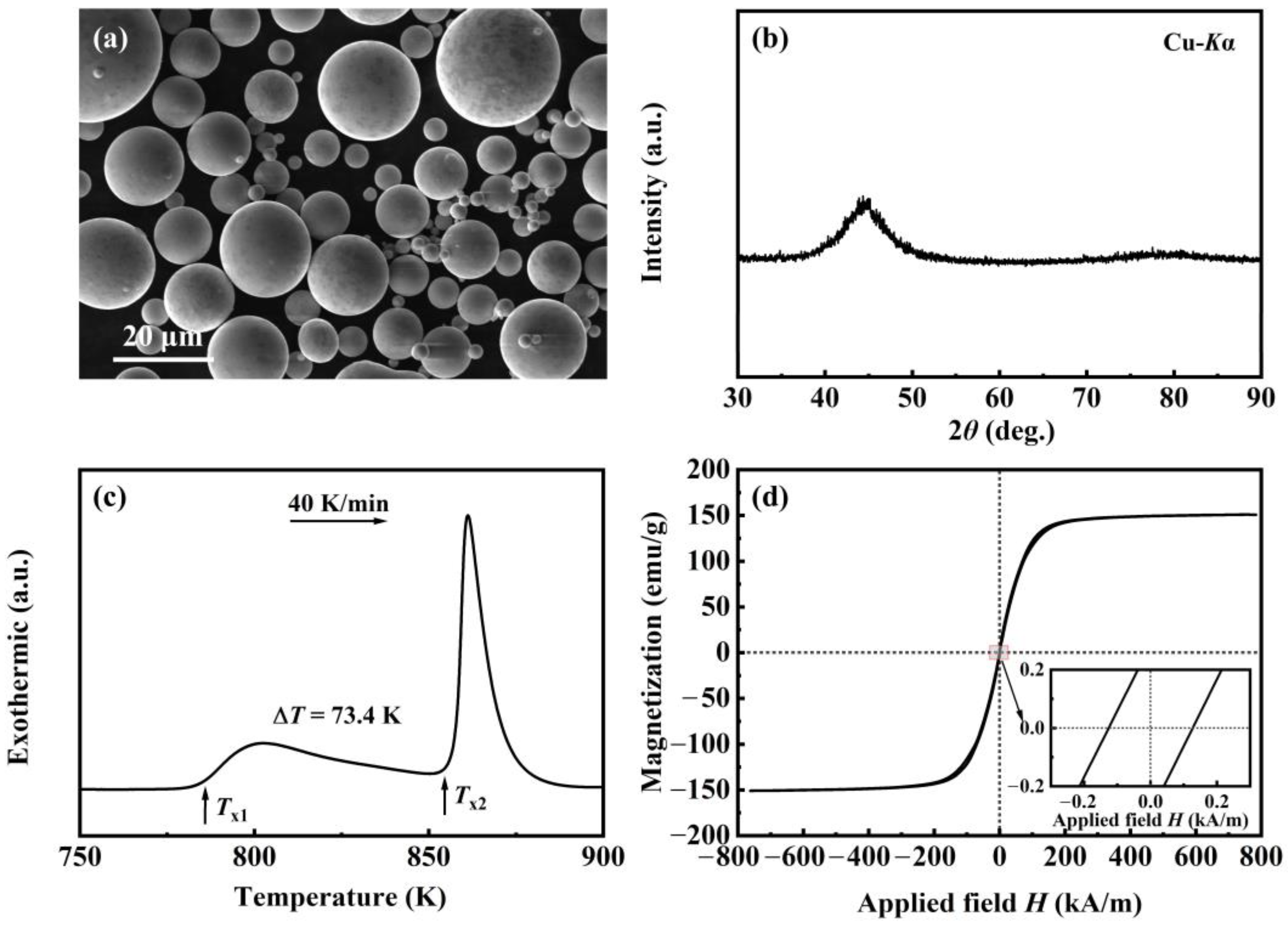

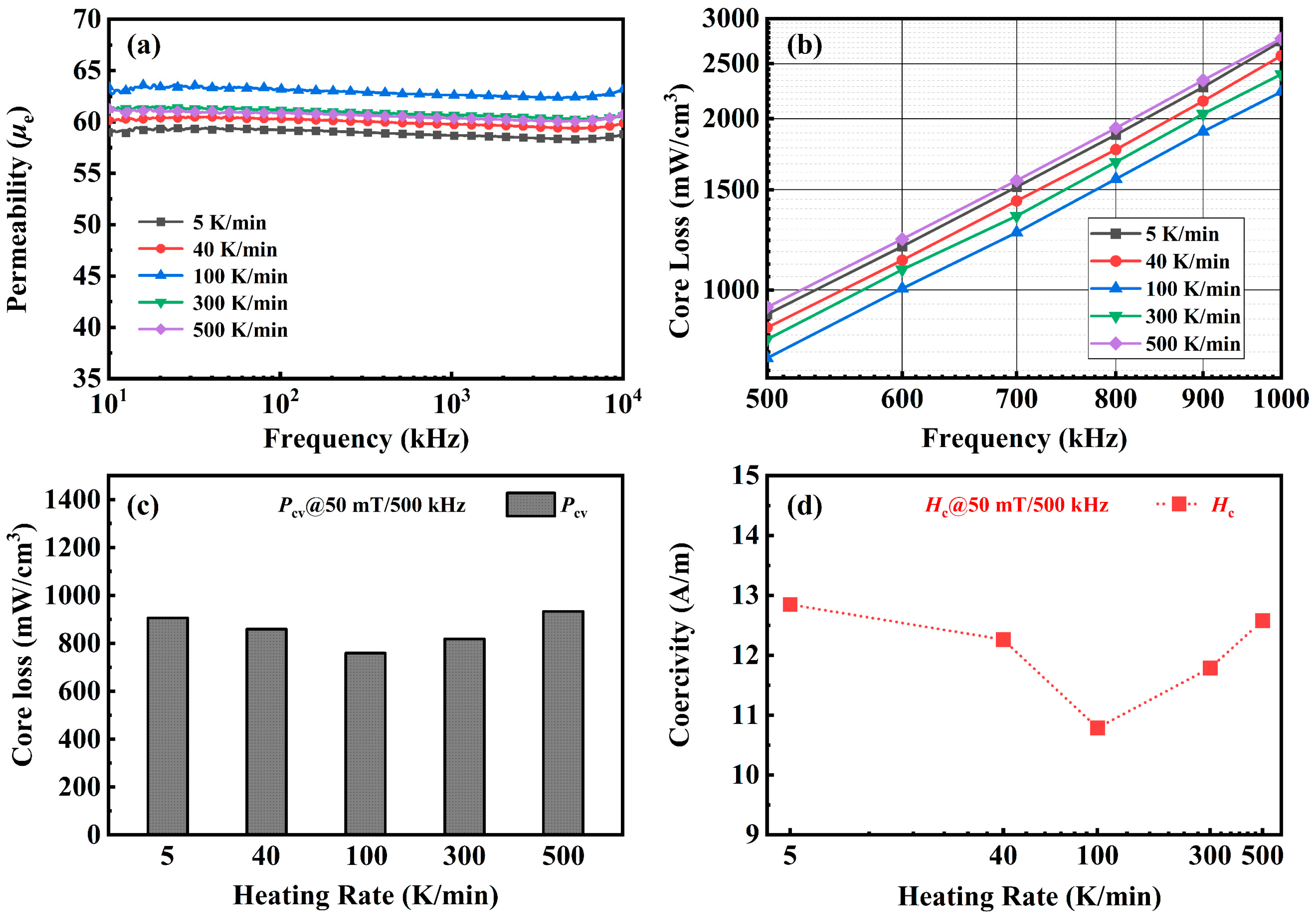
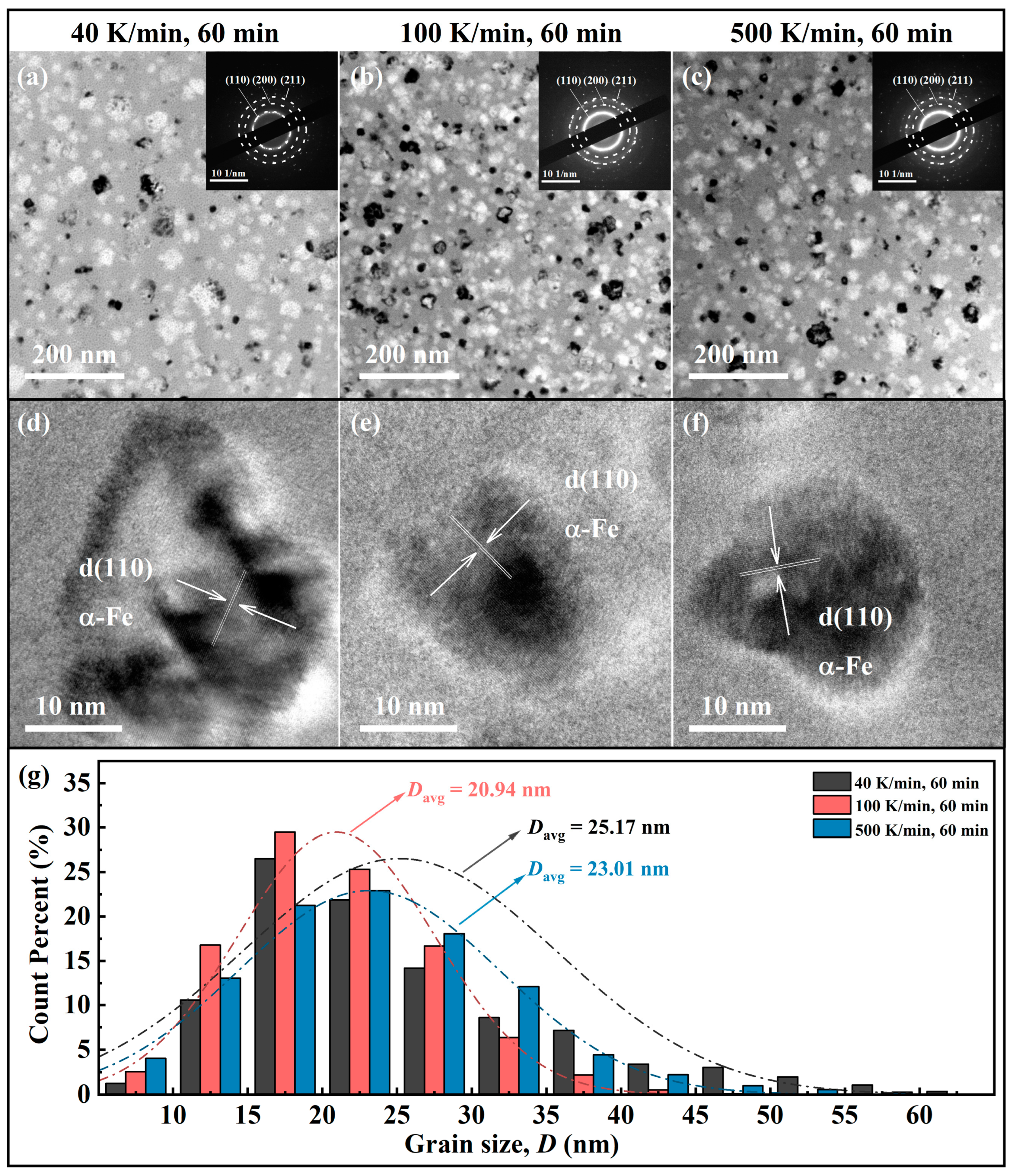
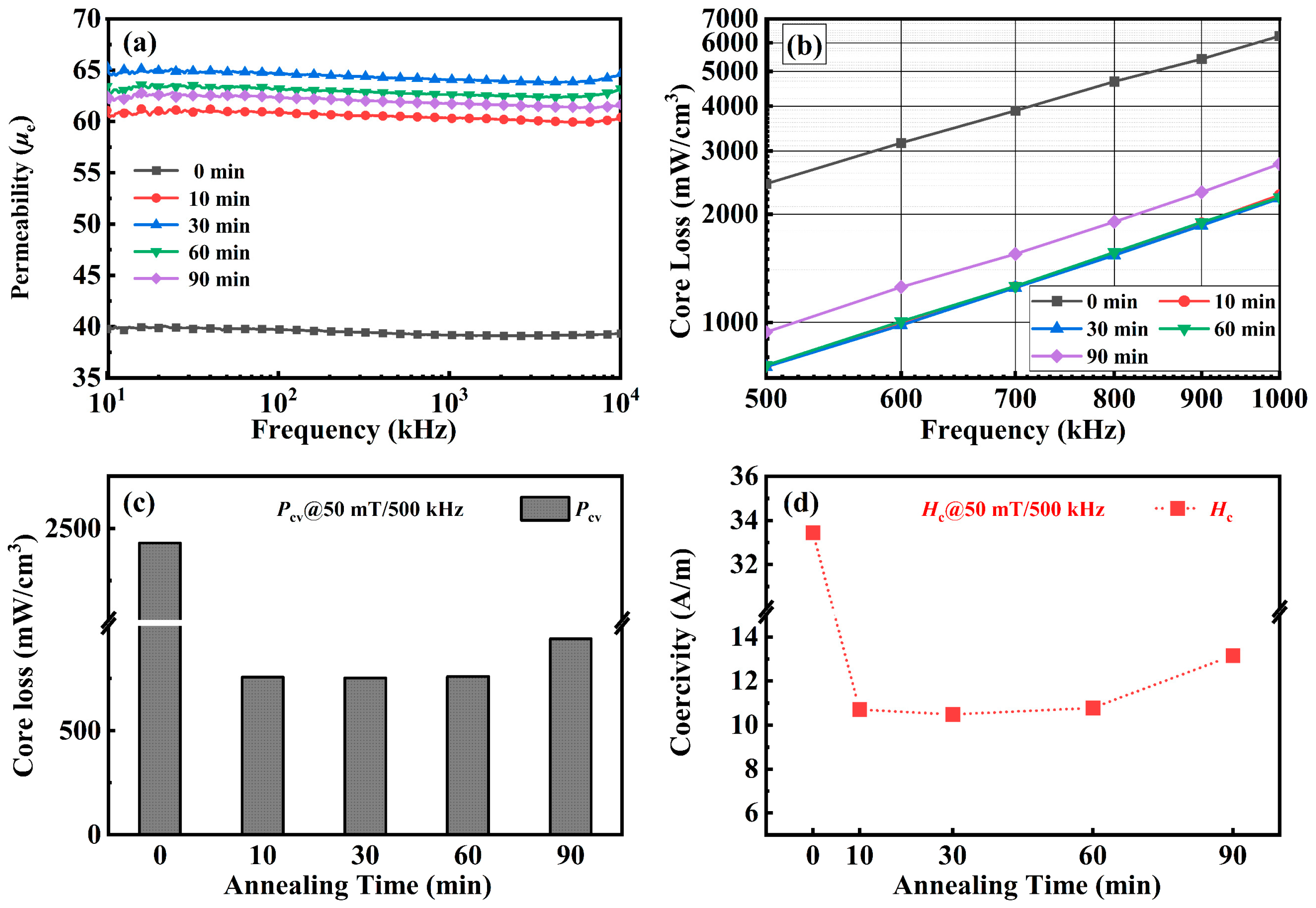
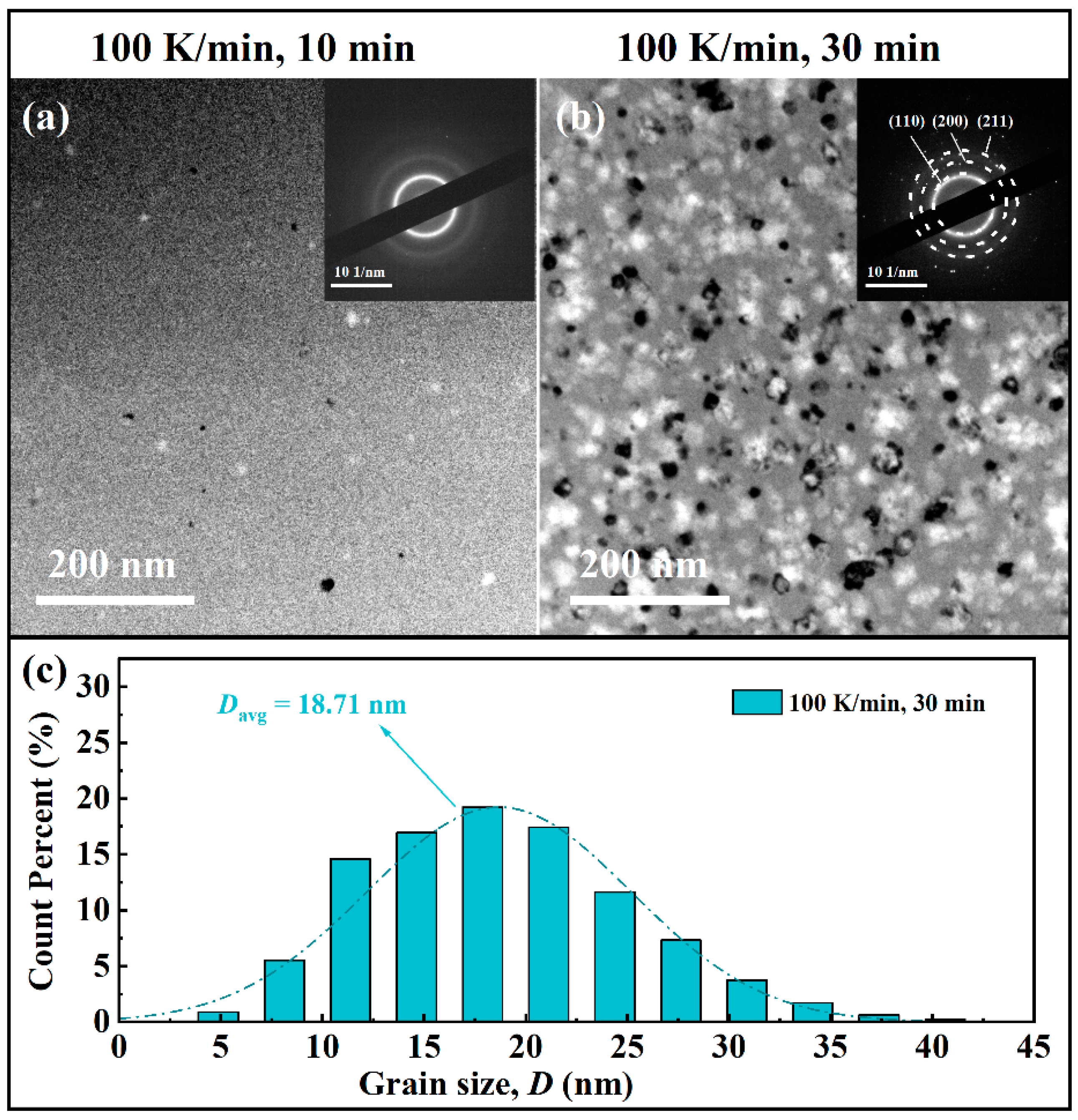

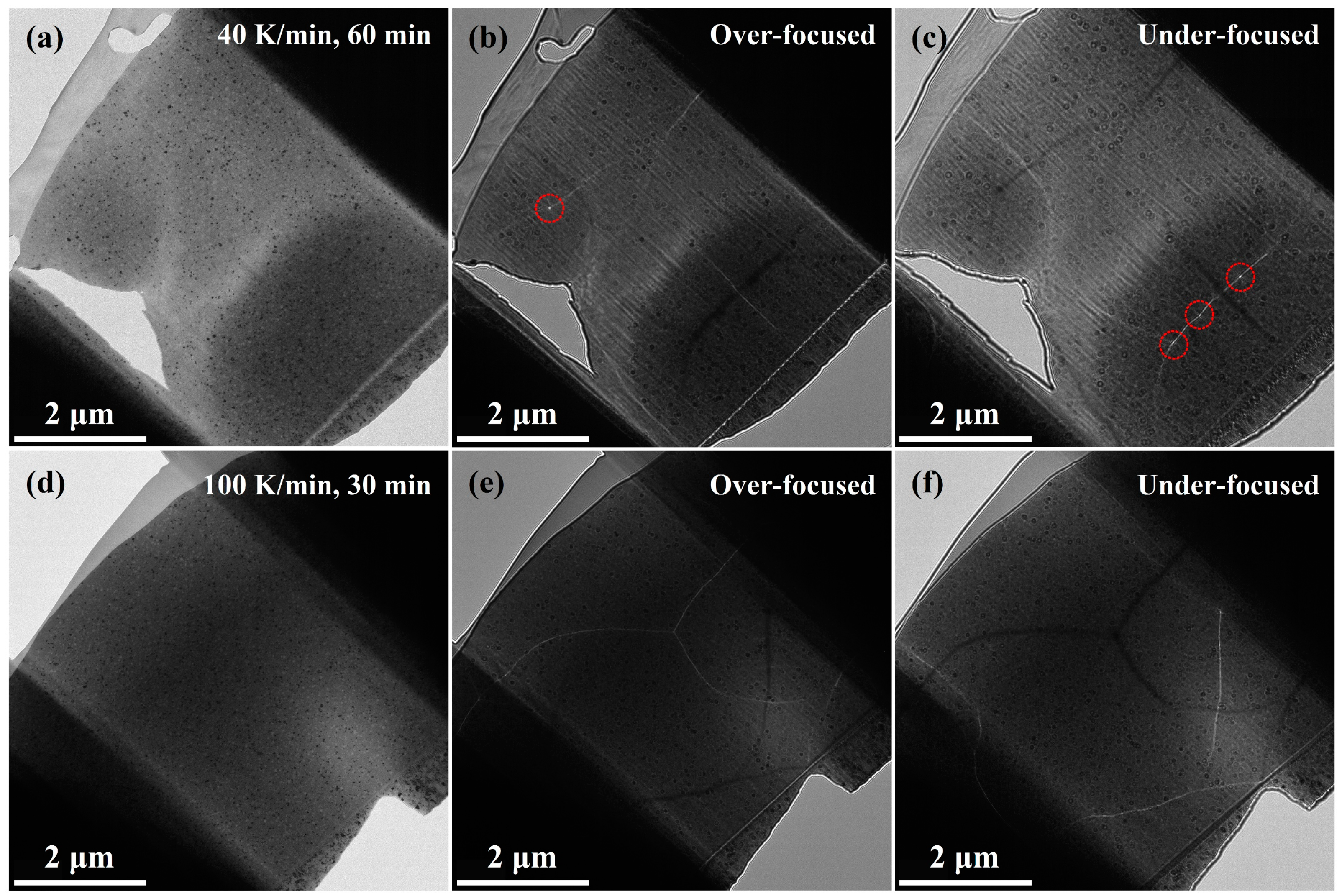
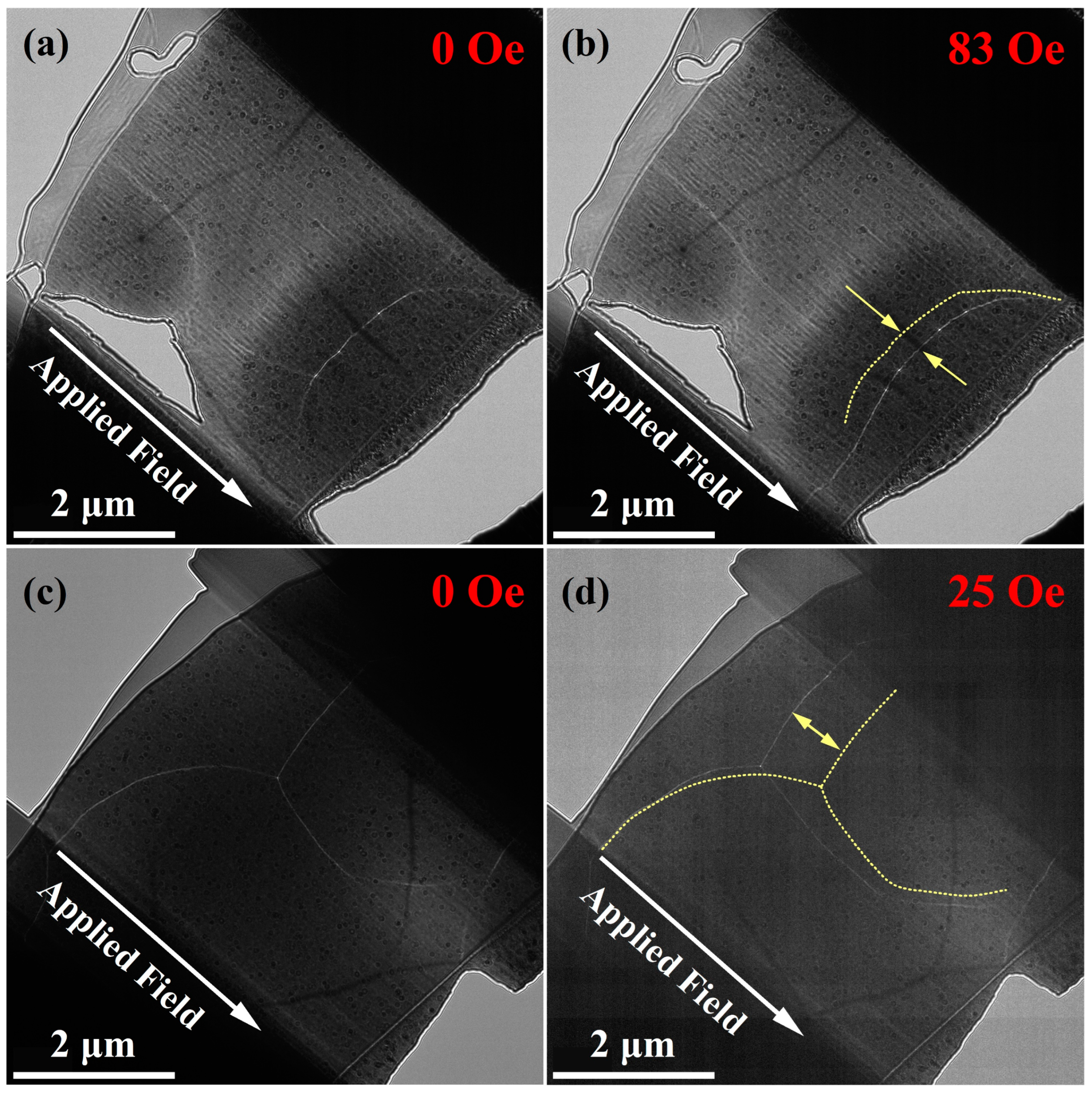
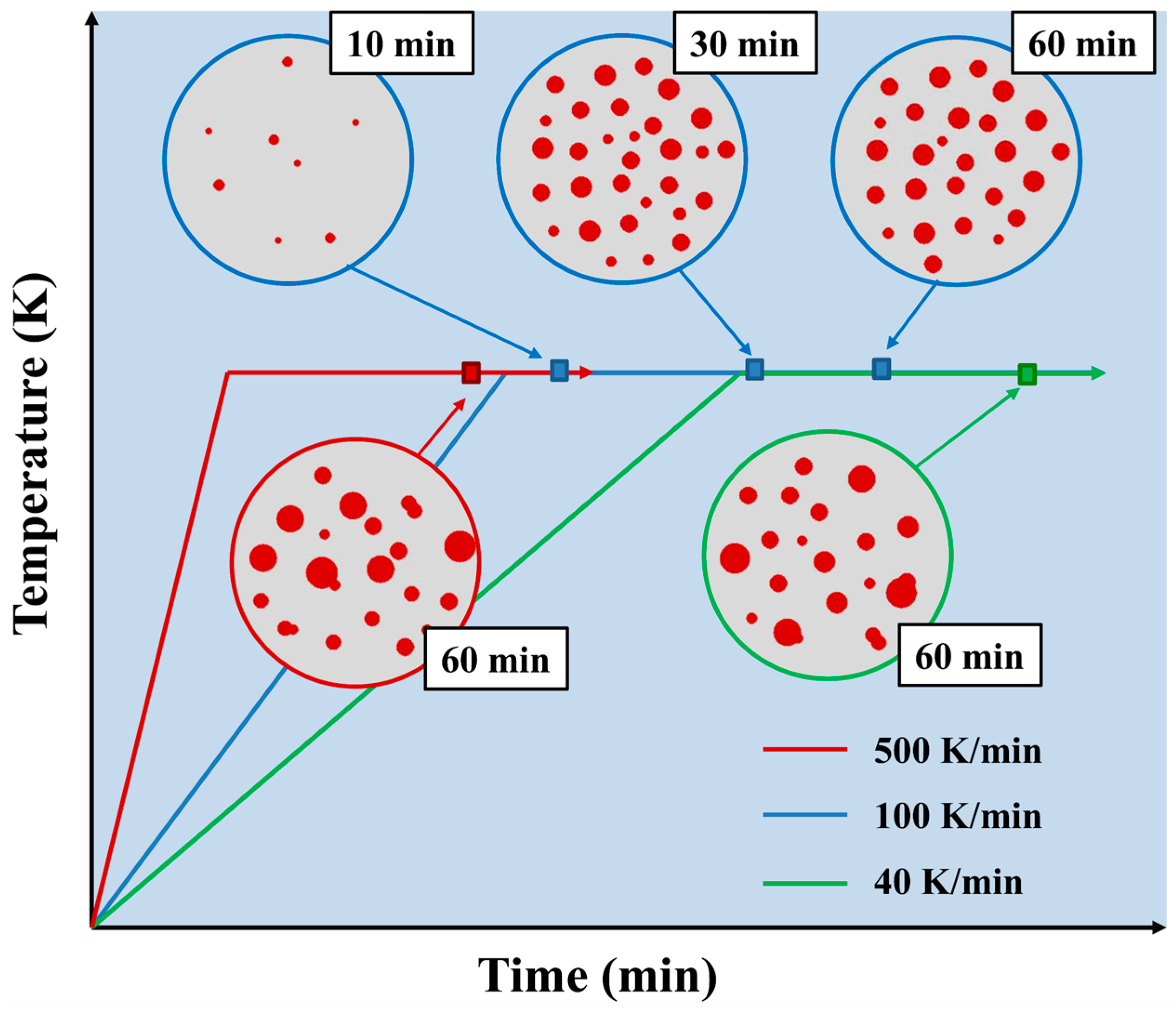
Publisher’s Note: MDPI stays neutral with regard to jurisdictional claims in published maps and institutional affiliations. |
© 2022 by the authors. Licensee MDPI, Basel, Switzerland. This article is an open access article distributed under the terms and conditions of the Creative Commons Attribution (CC BY) license (https://creativecommons.org/licenses/by/4.0/).
Share and Cite
Wu, Y.; Dong, Y.; Yang, M.; Jia, X.; Liu, Z.; Lu, H.; Zhang, H.; He, A.; Li, J. Effect of Annealing Process on Microstructure and Magnetic Properties of FeSiBPCNbCu Nanocrystalline Soft Magnetic Powder Cores. Metals 2022, 12, 845. https://doi.org/10.3390/met12050845
Wu Y, Dong Y, Yang M, Jia X, Liu Z, Lu H, Zhang H, He A, Li J. Effect of Annealing Process on Microstructure and Magnetic Properties of FeSiBPCNbCu Nanocrystalline Soft Magnetic Powder Cores. Metals. 2022; 12(5):845. https://doi.org/10.3390/met12050845
Chicago/Turabian StyleWu, Yue, Yaqiang Dong, Munan Yang, Xingjie Jia, Zhonghao Liu, Hao Lu, Haijie Zhang, Aina He, and Jiawei Li. 2022. "Effect of Annealing Process on Microstructure and Magnetic Properties of FeSiBPCNbCu Nanocrystalline Soft Magnetic Powder Cores" Metals 12, no. 5: 845. https://doi.org/10.3390/met12050845
APA StyleWu, Y., Dong, Y., Yang, M., Jia, X., Liu, Z., Lu, H., Zhang, H., He, A., & Li, J. (2022). Effect of Annealing Process on Microstructure and Magnetic Properties of FeSiBPCNbCu Nanocrystalline Soft Magnetic Powder Cores. Metals, 12(5), 845. https://doi.org/10.3390/met12050845





